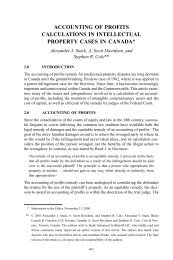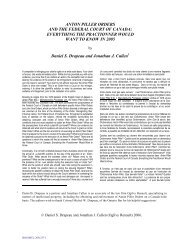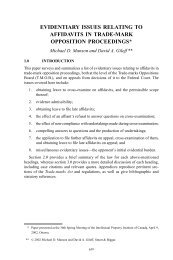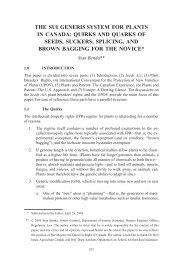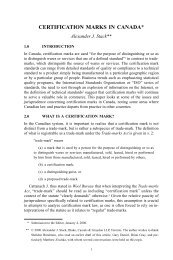A Comparative Overview of Canadian, US and European ...
A Comparative Overview of Canadian, US and European ...
A Comparative Overview of Canadian, US and European ...
Create successful ePaper yourself
Turn your PDF publications into a flip-book with our unique Google optimized e-Paper software.
Pediatric exclusivity/pediatric<br />
extension<br />
See Article 10 where Canada has<br />
indicated the value <strong>of</strong> providing<br />
added incentives for development<br />
<strong>of</strong> pediatric indications<br />
Duration<br />
See Article 10 <strong>of</strong> CETA where<br />
Europe proposes that data<br />
exclusivity be increased in<br />
Canada to 10 years with a<br />
maximum <strong>of</strong> 11 years as is<br />
currently provided for in Europe<br />
sponsor. Data exclusivity may also be important when the patent expires soon after the drug is launched, perhaps because <strong>of</strong><br />
regulatory delay.<br />
Several countries <strong>of</strong>fer a data exclusivity incentive to drug developers to carry the further expense <strong>of</strong> performing clinical trials in<br />
pediatric populations. These incentives were introduced to address a shortage <strong>of</strong> safety <strong>and</strong> efficacy studies specifically generated<br />
for this sub-population.<br />
Data protection in Canada is restricted<br />
to an “innovative drug”, a drug that<br />
contains a medicine not previously<br />
approved in Canada. Canada does not<br />
provide data protection for any<br />
subsequent new use <strong>of</strong> a previously<br />
approved drug.<br />
The maximum term <strong>of</strong> data protection<br />
is: 6+2+0.5 = 8.5 years, which is<br />
broken down as:<br />
no abbreviated submission<br />
for 6 years;<br />
no regulatory approval for<br />
additional 2 years; <strong>and</strong><br />
an additional 6 months for<br />
submissions that include<br />
pediatric studies.<br />
In the <strong>US</strong>, data protection is calculated differently<br />
for biological drugs versus small molecule drugs.<br />
Traditional pharmaceuticals are small molecules<br />
which are normally produced by chemical<br />
synthesis. Biological drugs are large complex<br />
molecules made through the metabolic activity <strong>of</strong><br />
living organism, which typically involves cloning,<br />
selection <strong>of</strong> a suitable cell line, fermentation <strong>and</strong><br />
purification. (The <strong>US</strong> <strong>of</strong>fers a shorter term <strong>of</strong> data<br />
protection for small molecule drugs, i.e. 5 yrs, than<br />
for biologic drugs, i.e. 12 years, based on policy<br />
rationale that development <strong>of</strong> a biologic drug is far<br />
more complex <strong>and</strong> costly than for small molecule<br />
drugs such that a longer minimum term <strong>of</strong> market<br />
exclusivity is required for biologic drugs to provide<br />
an adequate incentive to innovate in this field.)<br />
For biological drugs, the st<strong>and</strong>ard term <strong>of</strong> data<br />
protection is 12 years. The six-month period for<br />
pediatric studies may be added to either the<br />
maximum patent term or the maximum term <strong>of</strong><br />
data protection, such that the maximum data<br />
protection for biologics may be 12.5 years.<br />
For small molecule drugs, the maximum is: 5 + 3<br />
+0.5 = 8.5, which is broken down as:<br />
no abbreviated submission for 5 years,<br />
unless patents are challenged (patents<br />
cannot be challenged within first 4 years<br />
<strong>of</strong> drug approval);<br />
an additional 3 years data exclusivity for<br />
significant changes (new indication);<br />
<strong>and</strong><br />
an additional 6 months for submissions<br />
that include pediatric studies.<br />
In Europe, the maximum is: 8+2+1=<br />
11 years, which is broken down as:<br />
no abbreviated<br />
submission for 8 years;<br />
no regulatory approval<br />
for an additional 2 years;<br />
<strong>and</strong><br />
an additional 1 year data<br />
exclusivity for significant<br />
changes (new indication).<br />
Sponsors must conduct pediatric<br />
studies, where applicable, <strong>and</strong> the<br />
incentive is built into the base term<br />
(8+2).<br />
This is a brief <strong>and</strong> very simplified summary <strong>of</strong> selected aspects <strong>of</strong> the three patent systems. It is intended for general informational purposes <strong>and</strong> should not be<br />
used as a basis for taking decisions with regards to any specific cases. Qualified advice should be sought regarding any specific fact situations. All references<br />
WSLegal\049190\00037\8068137v1<br />
to CETA are based on our underst<strong>and</strong>ing <strong>of</strong> the provisions <strong>of</strong> CETA, as determined from sources available on the Internet. IPIC ©2012<br />
19/24



